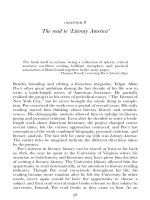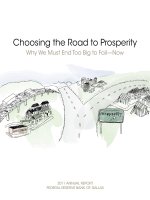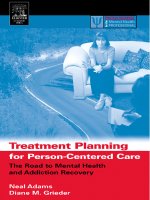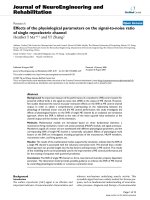5 4 on the road to revolution
Bạn đang xem bản rút gọn của tài liệu. Xem và tải ngay bản đầy đủ của tài liệu tại đây (4.51 MB, 10 trang )
R
R
Fascinating Facts
• When Britain occupied Boston, there was one British
soldier for every four colonists.
• Land was very important to the colonists—nearly
90 percent of them were farmers!
• The British government thought the rebellion would be
easy to end. They did not believe that farmers would be
able to fight.
Genre
Nonfiction
Comprehension Skill
Cause and Effect
Text Features
•
•
•
•
Captions
Time Line
Map
Sidebars
Scott Foresman Social Studies
ISBN 0-328-14674-9
ì<(sk$m)=begheb< +^-Ä-U-Ä-U
A R
New taxes, lack of representation, and Britain’s demand that
private citizens feed and house British soldiers were some of
the issues angering American Patriots in the 1700s. What else
would need to happen before Americans would demand their
independence? Read about some of the events that led up to the
firing of “the shot heard round the world.”
Vocabulary
proclamation
R
R
Write to It!
Recall the reasons the British taxed the
colonies and the reasons the colonists
opposed taxes. Choose a pro-tax or an antitax position. Then write a speech to persuade
others to support your position. Your speech
should be at least two paragraphs long.
boycott
repeal
Write your speech on a separate sheet of paper.
tariff
massacre
intolerable
Patriot
militia
A R
minutemen
Photographs Every effort has been made to secure permission and provide appropriate credit for photographic material.
The publisher deeply regrets any omission and pledges to correct errors called to its attention in subsequent editions.
Unless otherwise acknowledged, all photographs are the property of Scott Foresman, a division of Pearson Education.
Photo locators denoted as follows: Top (T), Center (C), Bottom (B), Left (L), Right (R), Background (Bkgd).
ISBN: 0-328-14674-9
Copyright © Pearson Education, Inc. All Rights Reserved. Printed in the
United States of America. This publication or parts thereof, may be used with appropriate
equipment to reproduce copies for classroom use only.
1 2 3 4 5 6 7 8 9 10 V0G1 14 13 12 11 10 09 08 07 06 05
Opener: (Ca) ©Geoffrey Clements/Corbis, (Cb) Getty Images
3 ©Bettmann/Corbis
5 North Wind Picture Archives
6 ©Private Collection/Bridgeman
ArtOffices:
Library Glenview, Illinois • Parsippany, New Jersey • New York, New York
Editorial
8 ©Bettmann/Corbis
Offices: Needham, Massachusetts • Duluth, Georgia • Glenview, Illinois
11 The Granger Collection,Sales
New York
12 ©Massachusetts Historical
Society,
Boston,
MA, USA/Bridgeman
Coppell,
Texas
• Ontario,
CaliforniaArt
• Library
Mesa, Arizona
13 (Tb) ©New-York Historical Society, New York, USA/Bridgeman Art Library, (Ta) Getty Images
15 ©Revere, Paul. Letter to Jeremy Belknap, [1798]. Manuscript Collection/ Massachusetts Historical Society
Setting the Scene: The American Colonies in 1763
From 1756 to 1763, all the great powers of Europe were
engaged in the Seven Years’ War. France, Austria, Great Britain,
Russia, and many other countries battled over land in Europe—
and over their colonies. The part of this war that was fought in
North America came to be known in the United States as the
French and Indian War.
When the Seven Years’ War ended in 1763, and the French
and Indian War with it, Great Britain had won most of France’s
North American territories. Great Britain was now one of the
most powerful countries in the world, and many American
colonists were pleased to be part of this powerful empire.
However, tensions between Great Britain and its colonies would
soon develop.
With the war over, King George III of Great Britain began to
take an active interest in his now much larger colonies in the
Americas. Unfortunately for King George, new ideas were
becoming popular in the 1700s — ideas that would make it
difficult for him to control his colonies.
The term “natural rights” was beginning to be used in
political debates and in writing. People began discussing the
rights of the individual. Among the many rights they discussed
were the rights to be free, to own property, and to participate
in government.
2
People in the Thirteen Colonies had come to enjoy rights and
freedoms that people in Europe only discussed. When new laws
were passed, many colonists felt that the British government was
interfering with their rights and freedoms.
This map shows the thirteen American colonies in 1763.
3
Sowing the Seeds of Conflict
The Seven Years’ War had left Great Britain with huge debts,
so some of the growing interest in the colonies was interest in
colonial money. Many British leaders felt that Britain’s American
colonies should help pay the war debts. After all, were the
colonists not loyal subjects of the king? Had they not benefited
from having the French defeated?
In 1764 the British government enacted the first in a series of
tax laws that they hoped would increase revenues, or money
coming in, from the American colonies. The Revenue Act of
1764, also called the Sugar Act, set taxes on sugar and molasses
from non-British ports. In addition to raising revenue, this act
was designed to stop colonists from buying sugar from French
and Dutch traders. The taxes angered many colonists, who
wanted to buy less expensive sugar, even if they were buying
from Great Britain’s enemies.
The following year, the British passed the Stamp Act, which
required colonists to pay a tax on documents, newspapers, and
other materials printed in the colonies. The colonists were
outraged, and many refused to pay.
4
Tax stamps such as these could be attached to
printed materials to show that the tax had been paid.
Representatives from nine colonies met in New York to
protest the Stamp Act. They pointed out that colonists were
British subjects, and that one of their rights was that only their
elected representatives could tax them. Because they had no
representatives in Parliament, the colonists argued, Parliament
should not tax them. They accused Parliament of tyranny, the
cruel or unfair use of power. The slogan “Taxation without
representation is tyranny” became popular.
Colonists were not buying British goods, which hurt British
merchants. Also, Parliament realized that it was unlikely that it
would ever collect much revenue from this tax, so the Stamp
Act was repealed in 1766.
5
The same year in which the Stamp Act was
passed, 1765, Parliament passed the Quartering
Act. This law required colonists to care for
British soldiers stationed in the American
colonies. British lawmakers felt that colonists
should help pay for the soldiers who were
protecting the colonies. Colonists were
responsible for providing food, drink, housing,
coal or firewood, and candles to troops stationed
in their towns.
Many colonists obeyed the Quartering Act,
but because many resented it, they often
provided fewer supplies than the soldiers needed.
The colony of New York had to support the
largest number of soldiers, so tensions were
greatest there. When the New York Assembly refused at first to
assist with quartering British troops, a fight occurred, and a
colonist was wounded.
At the same time Parliament repealed the Stamp Act, in
1766, it issued the Declaratory Act. This act stated that
Parliament had the right to tax the colonies for any reason. It
was not until the next year that colonists learned what would be
taxed next.
In 1767 Britain passed the Townshend Acts. One of these
laws prohibited the New York Assembly from conducting
business until it met the requirements of the Quartering Act.
Another law created tariffs on many imported goods. A third
act established a system of customs, or tax collection, in the
colonies and included a Board of Customs Commissioners in
Boston. In 1768 soldiers were sent to Boston to keep order and
to enforce the Townshend Acts.
Angry colonists organized boycotts of British goods, which
hurt British merchants. On March 5, 1770, the British
Parliament agreed to repeal some of the taxes. However, it did
not repeal the tax on tea. That same day, an incident occurred in
Boston that would dramatically increase anti-British feelings in
the colonies.
6
7
British soldiers arrive at Long Wharf, Boston Harbor, 1768.
John Adams
Violence Erupts
Fistfights between soldiers and colonists were becoming fairly
common in Boston. On March 5, 1770, however, a much more
serious incident occurred. According to some reports, a
threatening crowd had surrounded a group of British soldiers
outside the Custom House. The crowd rapidly grew in size,
taunting the soldiers and hurling objects at them. The
commanding officer told his soldiers to hold their fire. However,
when a snowball hit a soldier, first one startled soldier and then
another fired into the crowd. In the end, three people were killed,
and eight more were wounded. Two of the wounded later died.
This picture by Paul Revere is not really accurate, but it
shows how the people of Boston felt about the shootings,
and it helped fuel anti-British feelings.
8
A Patriot leader who opposed Britain’s right to tax the
American colonies, John Adams still upheld the rights of the
British soldiers involved in the Boston Massacre. His defense
of the soldiers made him unpopular for a time, but Adams
continued to be an important Patriot leader. He was elected to
the First Continental Congress in 1774. In 1797 he became
the second President of the United States.
Patriots, or colonists who opposed British rule, called the
incident the Boston Massacre. Newspaper accounts picked up
the name, and soon many colonists were rallying in opposition
to British policies in the colonies. Although the killing of five
people could not be defined accurately as a massacre—the
needless killing of a large number of people—it was a violent
event that showed how strained relations between the colonists
and the British had become.
Like many colonists, Samuel Adams thought the use of
soldiers against civilians was a symbol of tyranny. He proclaimed
that the Boston Massacre was a battle for American liberty.
The British soldiers were put on trial. Lawyer John Adams, a
cousin of Samuel Adams, and his assistant, Josiah Quincy,
defended them. Adams argued that the crowd had provoked the
soldiers, and therefore the soldiers were innocent of murder.
Two of the soldiers were later found guilty of manslaughter,
which meant they hadn’t planned to kill anyone. As was the
custom in those days, the two guilty of manslaughter were
branded on their thumbs as punishment.
9
After the Boston Massacre
The British withdrew their troops to an island in Boston
Harbor shortly after the Boston Massacre, thanks in part to the
efforts of Samuel Adams. In 1772 Adams and other Boston
leaders formed a Committee of Correspondence. Express riders
delivered their correspondence, or letters, to other communities,
keeping them informed of local events and how groups of
Patriots hoped to stop Great Britain’s interference. This network
of writers and riders helped unite the colonies.
Tea and the East India Company
This picture shows Patriots destroying tea during the Boston Tea Party.
The East India Company, formed in 1600, imported spices
and cloth from India. In the 1700s, it began importing tea
from China. Tea became very popular in Great Britain—more
popular than drinks that were taxed. So tea was taxed. The
British were as unhappy as the colonists would be later.
Tea smuggling became common, which hurt the East India
Company. However, the company was a source of revenue
for the British government, so the government created
laws to protect it. One law stated that tea could be sold
in the colonies only by agents of the East India Company.
This looked to the colonists as though the government was
controlling the tea trade. It was this, even more than the tax,
that caused the colonists to rebel against the Tea Act.
Samuel Adams also organized resistance to the Tea Act. The
tax on tea still existed after the Townshend Acts had been
repealed in 1770. After all, the British government needed to
have some way of showing that it had the right to tax the
colonies. However, the colonists had gotten around this tax by
buying tea smuggled in by Dutch traders.
In 1773 the British passed the Tea Act, a law that reduced
taxes on tea and made it easier for the East India Company to
sell tea to the colonies. It also stated that only agents of the East
India Company could sell the tea to stores in the colonies. So
independent shippers and traders in the colonies were going to
lose business.
10
11
Heading Toward Revolution
The tea in this bottle
was collected by T.M.
Harris, Dorchester Neck,
December 1773.
The East India Company’s tea would be able to compete with
the smuggled tea because their prices would be the lowest
available, even though the tea was still taxed! But the colonists
did not like the idea of the British government taxing them, and
despite the lower price, they would not buy the tea.
Although tea was much loved in the colonies, merchants in
New York, Philadelphia, Charleston, and other cities canceled
tea orders or refused shipments. However, the British-appointed
governor in Boston wanted to obey the law. He insisted that
three ships waiting in the harbor be allowed to unload their
cargo of tea—and that they be paid for it.
A group of Patriots had other plans for the tea. On the night
of December 16, 1773, a group of about sixty men disguised
themselves as Mohawks and boarded the ships. A larger crowd
of Bostonians had come with them, and they watched from the
docks as the smaller group dumped chest after chest of tea into
the harbor. Colonists knew this was an important event, and
some collected samples of tea as souvenirs.
Parliament passed several laws in 1774 to punish Bostonians
and to show others what could happen if they defied British
authority. Colonists called these the Intolerable Acts, because
they were intolerable, or unbearable. The port of Boston was
closed, unapproved town meetings were banned, and British
soldiers returned. Samuel Adams sent letters throughout the
colonies pointing out that Britain could interfere with other
colonial governments, just as it had in Massachusetts.
From September 5 to October 26, 1774, representatives from
every colony except Georgia gathered in Philadelphia for the
First Continental Congress. They voted to cease trade with
Britain until the Intolerable Acts were repealed. Most of the
representatives were not in favor of
independence, but they agreed to begin
strengthening their militias. They
also agreed to a second meeting in
May 1775 if Britain had not
changed its policies by then.
In February 1775 Britain
declared that Massachusetts was
in open rebellion. Two months
later, General Gage, who now
controlled Boston, received secret
orders to arrest leaders of the
rebellion, including Samuel Adams.
The Patriot leaders learned of this
and fled to Lexington.
Samuel Adams
12
13
On April 18, 1775, Patriots in Boston learned that British
soldiers were planning a nighttime march to Lexington, to
search for the Patriot leaders, and then to Concord, to destroy
Patriot supplies. They knew that the militia must be warned!
At 11 P.M., Paul Revere galloped on horseback out of Boston
to warn militias and leaders that the British were coming.
William Dawes and Samuel Prescott joined him along the way.
The three reached Lexington, but a British patrol stopped them
as they left. Only Prescott escaped to reach Concord. However,
the militia had been alerted by Prescott, and minutemen were
ready when the British arrived in Lexington.
The next day, fighting began between British soldiers and
American Patriots in Lexington, Massachusetts. No one knows
who fired the first shot, but it marked the beginning of the
Revolutionary War in America.
Key Events on the Road to Revolution
1766
Parliament passes
the Revenue Act of
1764, also called
the Sugar Act.
The French and
Indian War ends.
1761
1763
1765
The Shot Heard Round the World
In 1836 American writer Ralph Waldo Emerson described
the first shot fired by the Patriots at Lexington as “the shot
heard round the world.” The Patriots’ success in gaining
independence would inspire people in many other lands
to fight for the independence of their own countries.
1770
1764
1763
This is a letter written by Paul
Revere, in which he describes the
events of April 18–19, 1775.
Parliament
abolishes the
Stamp Act, but
passes the
Declaratory Act.
1767
March 5:
Parliament
repeals the
Townshend Acts,
except for the
tax on tea.
The Boston
Massacre occurs.
1769
1773
Parliament passes
the Tea Act.
December 16:
The Boston Tea
Party occurs.
1771
1775
April 19: The
Revolutionary War
in America begins.
1775
1773
1765
1767
1774
The Quartering Act of 1765 and
the Stamp Act are enacted by
Parliament.
Parliament passes
the Townshend Acts.
Parliament passes the Intolerable Acts.
September 5–October 26: The first Continental
Congress meets in Philadelphia.
14
15
New taxes, lack of representation, and Britain’s demand that
private citizens feed and house British soldiers were some of
the issues
angering American Patriots in the 1700s. What else
Glossary
would boycott
need to happen
before
Americans
would demand their
organized
refusal
to buy goods
independence? Read about some of the events that led up to the
intolerable unbearable; too much to be endured
firing of “the shot heard round the world.”
massacre the cruel and needless killing of many
people
militia a volunteer army
Vocabulary
minutemen colonial militia groups that could be
proclamation
ready to fight at a minute’s notice
boycott
Patriot a colonist who opposed British rule of the
American Colonies repeal
repeal to cancel
Write to It!
Recall the reasons the British taxed the
colonies and the reasons the colonists
opposed taxes. Choose a pro-tax or an antitax position. Then write a speech to persuade
others to support your position. Your speech
should be at least two paragraphs long.
Write your speech on a separate sheet of paper.
tariff
massacre
revenue money coming
in; income
intolerable
tariff a tax on imported
goods
Patriot
tyranny cruel or unfair
use of power
militia
minutemen
Photographs Every effort has been made to secure permission and provide appropriate credit for photographic material.
The publisher deeply regrets any omission and pledges to correct errors called to its attention in subsequent editions.
Unless otherwise acknowledged, all photographs are the property of Scott Foresman, a division of Pearson Education.
Photo locators denoted as follows: Top (T), Center (C), Bottom (B), Left (L), Right (R), Background (Bkgd).
ISBN: 0-328-14674-9
Copyright © Pearson Education, Inc. All Rights Reserved. Printed in the
United States of America. This publication or parts thereof, may be used with appropriate
equipment to reproduce copies for classroom use only.
1 2 3 4 5 6 7 8 9 10 V0G1 14 13 12 11 10 09 08 07 06 05
16
Opener: (Ca) ©Geoffrey Clements/Corbis, (Cb) Getty Images
3 ©Bettmann/Corbis
5 North Wind Picture Archives
6 ©Private Collection/Bridgeman Art Library
8 ©Bettmann/Corbis
11 The Granger Collection, New York
12 ©Massachusetts Historical Society, Boston, MA, USA/Bridgeman Art Library
13 (Tb) ©New-York Historical Society, New York, USA/Bridgeman Art Library, (Ta) Getty Images
15 ©Revere, Paul. Letter to Jeremy Belknap, [1798]. Manuscript Collection/ Massachusetts Historical Society









